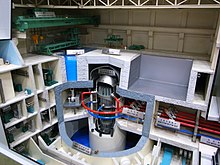
The advanced boiling water reactor (ABWR) is a Generation III boiling water reactor. The ABWR is currently offered by GE Hitachi Nuclear Energy (GEH) and Toshiba. The ABWR generates electrical power by using steam to power a turbine connected to a generator; the steam is boiled from water using heat generated by fission reactions within nuclear fuel. Kashiwazaki-Kariwa unit 6 is considered the first Generation III reactor in the world.
Boiling water reactors (BWRs) are the second most common[1] form of light water reactor with a direct cycle design that uses fewer large steam supply components than the pressurized water reactor (PWR), which employs an indirect cycle. The ABWR is the present state of the art in boiling water reactors[citation needed], and is the first Generation III reactor design to be fully built[citation needed], with several reactors complete and operating.[citation needed] The first reactors were built on time and under budget in Japan, with others under construction there and in Taiwan. ABWRs were on order in the United States, including two reactors at the South Texas Project site.[2] The projects in both Taiwan and US are reported to be over-budget.[3]
The standard ABWR plant design has a net electrical output of about 1.35 GW, generated from about 3926 MW of thermal power.
- ^ "Reactor Database Global Dashboard – World Nuclear Association". world-nuclear.org.
- ^ "NRG ends project to build new nuclear reactors". The Dallas Morning New. April 19, 2011. Archived from the original on April 9, 2016. Retrieved March 14, 2015.
- ^ Ruff, Julie (September 5, 2010). "$6.1 million spent to end nuclear deal". mySA.